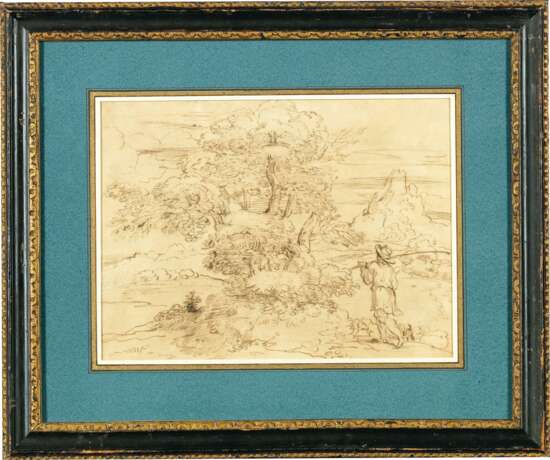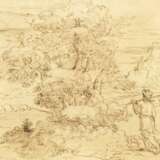ID 53111
Lot 125 | Annibale Carracci, attributed to
Valeur estimée
€ 12 000 – 15 000
Landscape with a big tree, a shepherd and his flock in the foreground, pen and brown ink, on laid paper, 20,2 x 27,3 cm, mounted, framed, ( Sch )
Provenance:
Collection Max Aaron Goldstein (1870-1941), St Louis, USA (Lugt 2824); auction sale Bassenge, Berlin, 31st May 2013, lot 6235 (as Agostino Carracci); private collection, France.
With a certificate by Dr. Nicholas Turner, 17th July 2013.
Literature:
see C. Loisel, Musée du Louvre, Département des Arts Graphiques, Inventaire Géneral des Dessins Italys, VII, Ludovico, Agostino, Annibale Carracci, Paris 2004, pp. 298-99, No 733; Drawn to Excellence. Renaissance to Romantic Drawings from a Private Collection, Exh. cat. Smith College Museum of Art, Northampton, Massachusetts, September 2012 – January 2013, No 33; The Drawings of Annibale Carracci, Exh. cat. National Gallery of Art, Washington, September 1999 - January 2000, pp. 288-89, No 95.
The present landscape drawing was attributed to Annibale Carracci by Dr. Nicholas Turner. Until recently the sheet was considered a work by Annibale’s brother Agostino Carracci (1557–1602). However, Agostino’s landscape studies never reached the same degree of perfection and artistic quality. On the basis of stylistic criteria, such as the vigorous and expressive lines and the compositional arrangement, Nicolas Turner suggests to date the present sheet to the Roman period of the artist around 1600.
Both in the composition of the scene and in the technical execution, the artist looked back to Venetian landscape drawings of the 16th century whose most important representatives Titian (c. 1488/1490–15769 and Domenico Campagnola (c. 1500–1564) exerted a big influence on Annibale. Like in the present sheet, Venetian artists had executed their landscape drawings in pen and brown ink. The half tones and transitions between light and dark were achieved by parallel and/or cross hatchings. Brown and grey washes were less common.
The numerous landscape drawings which Annibale executed during his Roman period around 1600 resemble each other in technique and composition. For the most part the centre of the depiction is determined by a tree or a group of trees; the surrounding landscape in the background is indicated only vaguely; the foreground is enlivened by figural scenes. The drawing “Landscape with a cowherd and cows” in the Musée du Louvre, Paris (Inv. 2450, comp. Loisel 2004, No 733) shows a comparable arrangement. The Louvre sheet appears sketchier and less elaborated; the arrangement of the figures and the way how space opens to the background are in accordance with the present sheet. The rendering of the leafage and of the tree’s branches reveal undoubtedly the virtuosity of Annibale. The vitality of the vegetation and its dominance compared to the surrounding made Annibale the founder of Italian landscape drawing – a genre which was still at the beginning of its development.
In the „Study of a Tree“ in a New York private collection, which can be considered as one of Annibale’s most beautiful nature studies, an exact parallel can be found in the virtuous execution of our drawing. (see Exh. cat. Massachusetts 2012, No 733). The cascade of rhythmic squiggles which indicate the leafage and the little circles representing the uneven nodules of the treetrunk, the vigorous parallel hatchings emphasizing the dark areas and the heavily accentuated lines, which represent the shaded contours of the treetrunk are identical in both drawings. In contrast to the New York study which is a mere nature study, Annibale succeeded in rendering a sense for the weather situation and for the atmospheric condition of the landscape. Dark and bright clouds mingle above the mountains in the background and anticipate an approaching thunderstorm. The dark clouds which are rendered somewhat deeper engulf the mountain and the distant landscape at the right. Only later, in his metaphysical landscape studies, as for example in the drawing „Landscape with the rising sun“ of the British Museum (Inv. 1972–7–22–13, comp. Exh. cat. Washington 1999, Cat. 95, pp. 288–89), Annibale reached a compelling synthesis of classical depiction of nature and the description of a constantly changing atmosphere in the sky which is vaulting the landscape. Annibale Carracci achieved a breakthrough in the development of Italian landscape drawing and thus became a model for following generations well into the 18th century.
We are grateful to Dr. Nicholas Turner for the scientific support.
The buyer‘s premium shall be as follows:
a) for items subject to margin tax (not specially marked in the catalogue/in the description) or for sales where the Dorotheum acts as an agent (marked with a “V” [“Vermittlung” = agent sale] in the catalogue/in the description):
■ up to an amount of EUR 100,000: 25% of the hammer price
■ for the amount exceeding EUR 100,000: 22%
■ for the amount exceeding EUR 600,000: 15%
In these cases the buyer‘s premium includes the statutory VAT
b) for fully taxable items (marked in the catalogue/in the description with the symbol „+“ for 20% VAT, with „–“ for 13% VAT or with „#“ for 10% VAT):
■ up to a hammer price of EUR 100,000: 20,84% of the hammer price
■ for the amount exceeding EUR 100,000: 18,34%
■ for the amount exceeding EUR 600,000: 12,5%
In the case under (b), the statutory VAT is calculated based on the total price (hammer price plus buyer‘s premium and a possible resale right royalty) and is added to the total price.
| Adresse de l'enchère |
Palais Dorotheum Dorotheergasse 17 1010 Wien Australie | ||||||||||||||
|---|---|---|---|---|---|---|---|---|---|---|---|---|---|---|---|
| Aperçu |
| ||||||||||||||
| Téléphone | +43 01 515600 | ||||||||||||||
| Fax | +43-1-515 60-443 | ||||||||||||||
| Conditions d'utilisation | Conditions d'utilisation | ||||||||||||||
| Modes de paiement |
Virement bancaire | ||||||||||||||
| Heures d'ouverture | Heures d'ouverture
|





